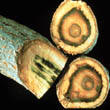|
Tree
problems and solutions
 Send a link to a friend
Send a link to a friend
By John
Fulton
[JUNE 6, 2006]
Many area trees are showing signs. Bad signs,
that is. Many are losing leaves, have dead branch ends or complete
dead branch areas. We can really break down the problems into about
three categories: leaf spot diseases; dead or injured trunks, roots
or crowns; and diseases that plug up the tissue that carries the
water and food within the tree.
|
|
Let's start with the group of leaf spot diseases. There are
many, but the most common are anthracnose, apple scab and
bacterial blights. The ones caused by a fungus have been well
"cussed and discussed," but to sum it up: There is no cure, they
are not life-threatening, and they could have been prevented
with time, effort and money. The spots caused by bacteria are
common on fruit trees, particularly cherries, and on pin oaks.
These are not curable, since you would have to treat with an
antibiotic, and even then the results aren't favorable on the
pin oaks. The fruit tree varieties come and go, but the scorch
on pin oaks kills branches and tips, going from the bottom up.
This eventually leads to the decline and death of the trees.
Even antibiotic treatments have not shown promise in our area of
the country. Dead or injured trunks, roots and crowns have
been a major problem in trees of all types, but maples have been
the major trees showing this problem in the last couple of
years. Of course, the dead roots and crowns are not noticeable.
The dead trunk areas are noticeable if you know what to look
for. Dead areas don't grow, while live ones do. This causes bark
to pop off where these two zones meet. You can also notice the
new growth areas trying to heal around the dead areas. Trunk
injuries can be caused by rabbits, mice, Weed Eaters or other
mechanical damage. Once dead, these areas won't recover. You
will have to make the determination on whether to keep the tree
or not.
[to top of second column]
 |
 The last category is the vascular system blockage. Many diseases
fall into this category. Verticillium wilt, oak wilt and most of the
canker diseases fall into the group. Usually a fungus "plugs the
pipes" so there is reduced movement of water up and food down. This
leads to dead areas above the blockage. Of course, if the blockage
is on the main trunk, you end up with a dead tree. With verticillium
wilt it is often possible to see streaking of the wood or a dark
ring around the center portion of the branch or trunk, but a lab
analysis is needed for definite confirmation. There are no cures for
any of these diseases at this time. It is recommended to remove and
destroy trees severely infected with verticillium, to help prevent
transfer from root grafting. The list of trees affected by
verticillium is very large, but good-quality maples are very
susceptible. The only treatment is to water and fertilize to try to
get new growth and new water- and food-carrying tissues.

Verticilium wilt shows up in these twigs as a dark
ring around the center portion.
We have really had 20-plus years of stressful weather. Just like
us, trees like moderate weather. When we have extreme heat and cold,
and no moisture or a flood, the trees are stressed. This stress
makes them more susceptible to things that are always in the
environment. Try to even out some of the extremes by watering when
it is dry, fertilizing when you do the lawn (or just fertilize the
tree) and mulching to even out the soil temperature in the root
area. Remember that many diseases can be passed with pruning
equipment, so disinfect your equipment between cuts.
[John
Fulton, unit leader,
University of Illinois Extension,
Logan County] |